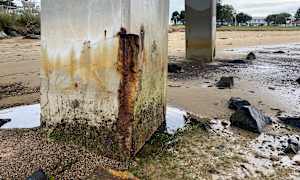THE Bass Coast Shire Council has welcomed one of the largest grants awarded, by the Federal Government, under its $50 million Coastal and Estuarine Risk Mitigation Program.
Underscoring the significance of the coastal erosion problem at Inverloch in particular, the shire has praised the government for awarding $3.3 million to the Department of Environment Land Water and Planning, for “on ground works” as part of the response to the Cape to Cape Resilience Project.
The trick now will be for the DELWP to make an early start on those “on ground works”.
According to the shire, the funding will assist in implementing works prescribed in the Regional Coastal Hazard Assessment that is being undertaken as part of the project.
“This project will reduce disaster risk to critical infrastructure and services for the Inverloch township and surrounding region,” said Bass Coast Shire Mayor, Cr Michael Whelan.
“Whilst work continues on the Cape to Cape Resilience Project, we saw the need for funding now to ensure actions can be implemented, rather than wait for funding cycles once the report is adopted,” he said.
“It is anticipated an initial $10 million will be required and this investment from the Federal Government is greatly appreciated.
“Both in the lead up to and post the Federal election, we met with Ministers on the need for urgent funding to mitigate the damage, protect residents and assets, and plan for the future.
“We continue to see great success from meetings both in Canberra and closer to home.
“This initial funding commitment alongside the establishment of a $200 million Disaster Ready Fund, shows that the government understands the impacts of climate change and the expected increased natural disasters and coastal hazards like storm surges, coastal inundation and shoreline erosion.
“We now call on candidates in the State election to make coastal erosion a priority.”
He said Council is one of many agencies responsible for managing coastal and marine areas. A Regional and Strategic Partnership (RaSP) brings these agencies together to respond to key issues.
The Inverloch RaSP is the first RaSP established under the Marine and Coastal Act 2018, and has 10 partners – Traditional Owners, the Bunurong Land Council Aboriginal Corporation, and nine agencies with responsibility for managing coastal land, assets and infrastructure in the Inverloch region.
The Inverloch RaSP will work with the community to address ongoing and future coastal erosion and inundation impacts. This includes delivering the Cape to Cape Resilience Project.
This project is managed by the Victorian State Government’s Department of Environment, Land, Water and Planning.
Two grants locally
There were two grants awarded locally under the Federal Government’s $50 million Coastal and Estuarine Risk Mitigation Program:
-
Cape to Cape Resilience Project $3.3 million for on-ground works. (Recipient: Department of Environment Land Water and Planning). This project will reduce disaster risk to critical infrastructure and services for the Inverloch township and surrounding region.
- South Gippsland Shire Coastal Levee Review and Infrastructure Planning $150,000. (Recipient: Department of Environment Land Water and Planning). This project will incorporate a coastal levees assessment with disaster risk mitigation and adaptation planning, aligned to progressing regional adaptation for communities and primary industries.
Successful applicants were announced on November 4, 2022 by the Minister for Emergency Management, Senator the Hon Murray Watt.
The purpose of the program is to address coastal hazards, such as inundation, storm surges and erosion that threatens a diverse set of social, natural and cultural assets, including public and private property and valued recreational and tourist areas, with flow-on social and economic impacts.
The Coastal and Estuarine Risk Mitigation Program will help drive long term resilience and sustainability by delivering priority projects that mitigate the impact of disasters on communities and economies.
Areas of focus for the program include:
- Adaptation and resilience actions, including investment in grey infrastructure and green-blue infrastructure (which includes nature based solutions)
- Planning, including local and regional risk assessments and mapping, business case development, preparation of community focused regional coastal management programs; and
- Investment in monitoring infrastructure and activities to understand the coastal and estuarine zone over time.










